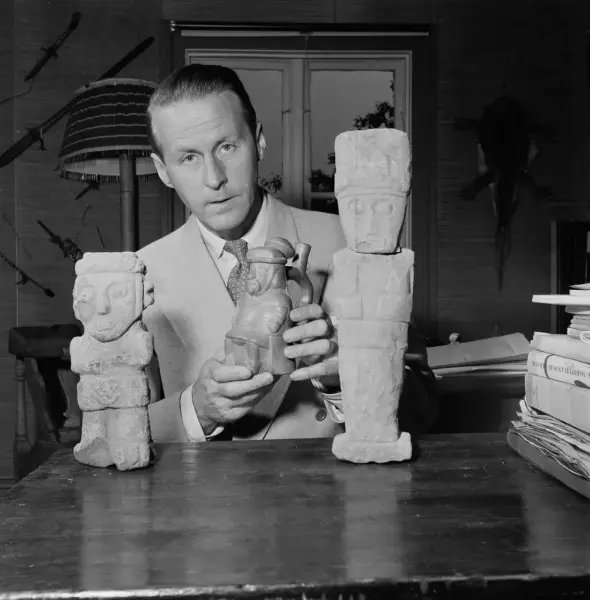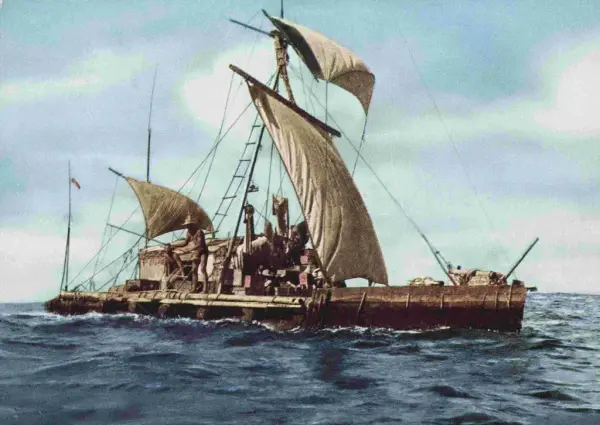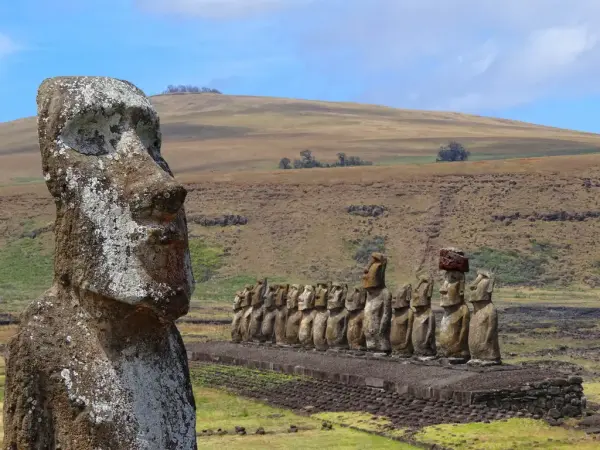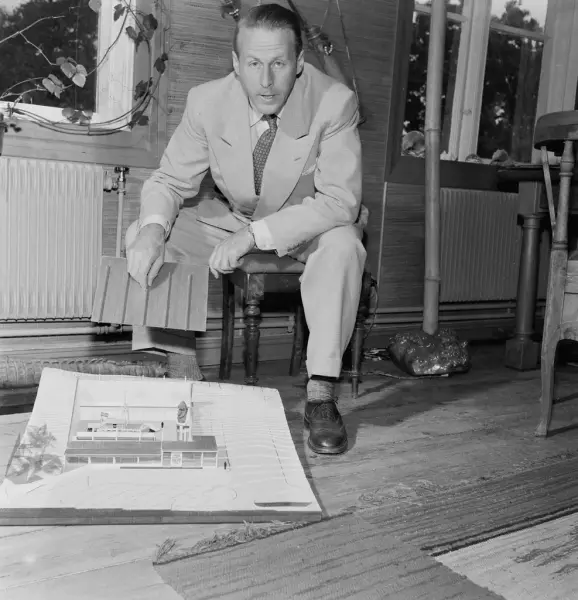- 1/4
Thor Heyerdahl in 1955 Bjørn Fjørtoft / Riksarkivet - 2/4
Nasjonalbiblioteket - 3/4
Bjørn Christian Tørrissen / Wikimedia Commons - 4/4
Bjørn Fjørtoft / Riksarkivet
Timeline – Thor Heyerdahl's life and work
1914
Thor Heyerdahl was born in Larvik on October 6, 1914, and grew up in Steingata 7 and lived there until he was 18 years old. He was the only child of Thor Heyerdahl and Alison Heyerdahl, née Lyng. His father was a brewmaster at Vestfold Bryggeri and his mother was, among other things, the head of the city's museum association.
Already at the age of 8 he made imaginative drawings of South Sea islands and he had decided to become an "explorer".
1933
After completing his high school diploma, Thor began studying zoology, biology and geography at the University of Oslo. Here he came into contact with Bjarne Kroepelien who would later play a major role in Thor's life.
1936
On Christmas Eve 1936, Thor married Liv, and on Christmas Day they set off by train, first to Marseille, then by passenger ship across the Atlantic through the Panama Canal, then across the Pacific to Tahiti and Fatu Hiva. In collaboration with the Faculty of Zoology at the University of Oslo, this was the first study trip to Polynesia. The purpose of the expedition was to investigate how animal species could have reached a deserted Pacific island.
1939 – 1940
When Thor Heyerdahl returned from Polynesia, he left the University of Oslo and at the same time switched from studying animal and plant life to studying a related area; how primitive seafarers of the past could have sailed across the ocean in open vessels. In 1939 he traveled to British Columbia where he was offered a study place at the museum in Victoria. Here he learned about the Indians on the northwest coast and their culture. During his stay, Heyerdahl also went out to live with indigenous people.
1942–1945
At the outbreak of World War II, Heyerdahl returned to Norway and volunteered for the "Free Norwegians of the Kreftene", and was eventually sent to Finnmark where he participated in a Norwegian Parachute Troop.
1947
In 1947, the balsa raft Kon-Tiki was launched; named after a legendary seafaring sun king who was worshipped both in the ancient Inca Empire and the islands of Polynesia. The fleet set sail outside the port of Callao in Peru with a crew of 6. Along with Thor were 4 other Norwegians, Herman Watzinger, Knut Haugland, Torstein Raaby and Erik Hesselberg and the Swede Bengt Danielsson. Over the course of 101 days, the fleet sailed about 8,000 km across the open Pacific Ocean and stranded on the atoll of Raroia in the Tuamotu archipelago. The voyage put to shame the view of the time of balsa rafts and proved that Polynesia was well within the reach of the South American navigators of the past.
1952
Following the success of the Kon-Tiki Expedition, Heyerdahl organized and led the Norwegian Archaeological Expedition to the Galapagos Islands. Many scientists had been to the islands previously (including Darwin), but no archaeologist. The expedition confirmed that there had been several visits from pre-Columbian South America to the islands of the Galapagos group over time. It also turned out that permanent settlement on the island was impossible because it was only possible to find drinking water during the rainy season. With the Galapagos expedition, South American archaeology was for the first time extended far into the Pacific Ocean.
1955–1956
In 1955, Heyerdahl embarked on a one-year expedition to Easter Island and the eastern parts of Polynesia.
1969
Ra was launched in the spring of 1969 in the old Phoenician port city of Safi in Morocco. To prove that people from different nations can work together even under stress and difficult conditions, Heyerdahl chose a crew of 7 men from 7 nations and set sail under the flag of the United Nations. Ra sailed westward with the trade winds and the North Equatorial Current. The reed bundles proved incredibly buoyant. Despite a broken rudder and oar and bad weather, Ra covered 5,000 kilometers in 8 weeks before the loss of the reed bundles on the starboard side caused Heyerdahl to abort the experiment.
1970
Ten months after "Ra I", "Ra II" was launched in Morocco and sailed the 6,100 kilometers to Barbados in 57 days.
1977
In 1977, Heyerdahl built his largest reed ship, "Tigris", and carried out an expedition from Iraq to the Persian Gulf and out into the Indian Ocean. The trip continued to Pakistan and across the Indian Ocean to Africa. The journey ended in Djibouti when the expedition was surrounded by war on all sides, and the expedition members decided to burn the boat. At the same time, the expedition members issued a unanimous appeal to the UN to stop arms deliveries to developing countries in a part of the world that had laid the foundation for our own civilization.
Unlike Kon-Tiki and the other two Ra boats, Tigris had sailed to predetermined ports regardless of wind and current conditions, and was still high enough at sea to end in flames.
2002
Thor Heyerdahl died on 18 April 2002. He was buried in Oslo Cathedral on 26 April. In addition to his family and close friends, the funeral was attended by King Harald and Queen Sonja and several representatives of the Norwegian public sector. Heyerdahl's urn was placed on the family estate in Colla Micheri in Italy.
Childhood in Larvik
Thor Heyerdahl was born on October 6, 1914 in Larvik. He was the son of brewery owner Thor Heyerdahl (1869–1957) and Alison Lyng (1873–1965). As a young boy he was interested in nature and animals, and at his home in Steingata 7 he created a museum, with a viper as one of the main attractions.
Studies
Heyerdahl moved to Oslo in 1933 to study. He also got in touch with Bjarne Kroepelien who had a private library with a large selection of books on Polynesia. Heyerdahl developed a burning interest in the subject. He studied zoology at the University of Oslo, but also had a great interest in related subjects such as biology, oceanography and anthropology and everything else that could be related to the Pacific Ocean. In 1936 he married Liv Coucheron Torp (born in 1916) from Brevik.
During World War II, he was trained as a soldier at Little Norway in Canada, later joined the parachute company of the Norwegian brigade in Scotland. Later he participated as a lieutenant in the Norwegian forces in Finnmark, Northern Norway.
Expeditions and archaeological excavations
Thor Heyerdahl wrote many books and articles about his expeditions and discoveries.
He also led several archaeological excavations, most notably in the Maldives (1983-1984), Tucume, Peru (1989-1994), Tenerife (1991, 1999-2000) and Azov, Russia (2001).
Recognition
Although few of Thor Heyerdahl's scientific theories have gained particular acceptance in broad scientific circles to this day, Heyerdahl received several honorary doctorates and other awards.
Thor Heyerdahl was appointed Commander of the Order of St. Olav in 1951, Commander with Star of the Order of St. Olav in 1970, and received the highest degree of the order, the Grand Cross of the Order of St. Olav in 1987. He was also a state scholar from 1984 and received the Royal Geographical Society's Gold Medal.
UNESCO heritage
Thor Heyerdahl died in Colla Micheri, Italy, on 18 April 2002. He was buried in Oslo Cathedral on 26 April. Present was his family and close friends, the funeral was also attended by King Harald and Queen Sonja and several representatives of the Norwegian public. Heyerdahl's urn was first placed on the family estate in Colla Micheri, Italy, but was moved to Larvik in 2024.
One of the Fridtjof Nansen-class frigates of the Norwegian Navy has been named KNM "Thor Heyerdahl". Thor Heyerdahl also had the high school in Larvik named after him, Thor Heyerdahl High School. In 1971 he was appointed an honorary citizen of Larvik.
In 2011, Thor Heyerdahl's archive was listed on the UNESCO Memory of the World List.
- 1/1
Fra Thor Heyerdahls barndomshjem i Larvik Georg Aamodt / Vestfoldmuseene




